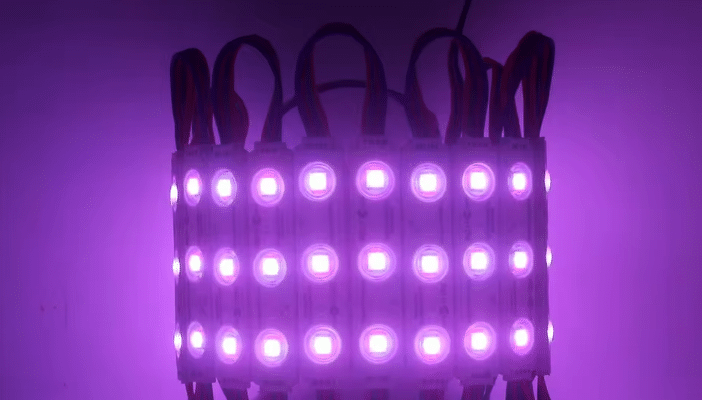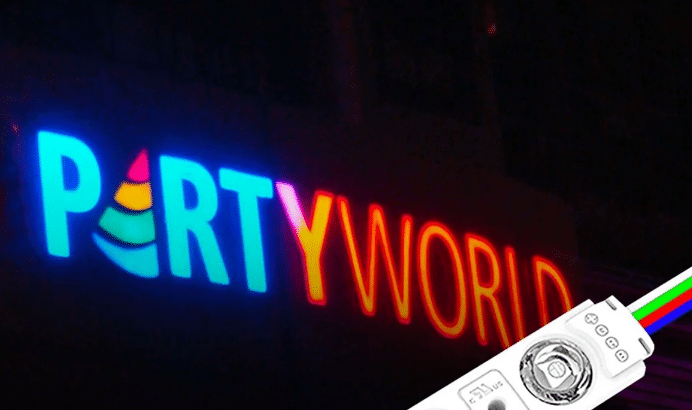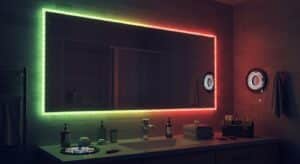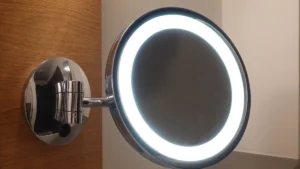
An RGB LED module combines red, green, and blue lights to create a wide spectrum of colors. You can control these modules to produce vibrant hues or subtle tones, making them ideal for dynamic lighting. Their ability to customize color has revolutionized industries like automotive, healthcare, and retail. The global market for RGB LED modules is growing rapidly, driven by demand for energy-efficient and durable lighting. By 2032, the LED module market is projected to reach $8.9 billion, reflecting their increasing role in smart lighting systems and IoT integration.
Key Takeaways
RGB LED modules mix red, green, and blue lights to make many colors. They are great for colorful lighting in different places.
These lights save energy and use less power than old bulbs. This helps lower electric bills and is better for the environment.
RGB LEDs last a long time, up to 50,000 hours. This means fewer replacements and steady performance.
They are flexible and work with smart home systems. You can control them with your voice or phone apps for custom lighting.
New tech like micro-LEDs and IoT will add more uses for RGB LEDs. They will be important for future lighting ideas.
What Is an RGB LED Module?

Definition and Structure
Components of an RGB LED module
An RGB LED module is a compact unit that combines three individual LEDs—red, green, and blue—on a single substrate. These modules rely on several key components to function effectively:
A substrate, such as sapphire or silicon carbide, serves as the base for the LED structure.
A first conductive semiconductor layer, which can be either n-type or p-type.
An active layer, where electrons and holes recombine to emit light.
A second conductive semiconductor layer, opposite in type to the first layer.
Electrodes (anode and cathode) that allow current to flow through the module.
This structure enables RGB LED modules to produce vibrant and customizable colors, making them ideal for various applications.
How RGB LEDs combine colors
RGB LEDs create a wide spectrum of colors by combining red, green, and blue light at different intensities. Each LED emits light when electrons and holes recombine in the active layer, releasing energy as photons. The wavelength of the emitted light depends on the semiconductor material used. By adjusting the current flowing through each LED, you can control the intensity of each color, enabling the creation of secondary colors and even white light.
Working Principles
Additive color mixing
RGB LED technology operates on the principle of additive color mixing. When red, green, and blue lights overlap, they form new colors. For example, combining red and green creates yellow, while mixing all three at full intensity produces white light. This process allows RGB LEDs to generate a broad range of colors, making them versatile for RGB lighting systems.
Control mechanisms for RGB lighting
RGB lighting systems use advanced control mechanisms to adjust brightness and color. Two common methods include:
Pulse Width Modulation (PWM): This technique rapidly switches the current on and off, controlling brightness based on the percentage of time the LED is active.
Constant Current Reduction (CCR): This method adjusts the current flow continuously, providing smooth dimming and precise control over the light’s intensity.
These mechanisms ensure that RGB LED modules deliver consistent and customizable lighting for diverse applications.
Advantages of RGB LED Modules
Versatility in RGB Lighting
Wide color spectrum and customization
RGB LED lights offer you an incredible range of colors. By adjusting the intensity of red, green, and blue diodes, you can create millions of unique hues. This flexibility makes RGB LEDs perfect for applications requiring dynamic lighting. Whether you want to set a calming ambiance in your living room or create vibrant displays for entertainment venues, RGB lighting adapts to your needs. The ability to customize colors also makes RGB LED technology a favorite for home decoration and commercial places.
Applications in dynamic lighting systems
RGB LEDs shine in dynamic lighting systems. You’ll find them in architectural and landscape lighting, where they highlight structures and outdoor spaces. They’re also common in stage and event lighting, delivering dramatic effects for performances. RGB lights are ideal for decorative and accent lighting, adding flair to both residential and commercial settings. Their versatility ensures they meet the demands of diverse environments, from entertainment venues to retail displays.
Energy Efficiency and Durability
Low power consumption
RGB LED modules consume far less energy than traditional incandescent bulbs. This efficiency reduces electricity bills and makes them an eco-friendly choice. If you switch to RGB LED lights, you’ll notice significant energy savings without compromising brightness or color quality.
Long lifespan and reliability
RGB LEDs last much longer than conventional lighting options. With a lifespan of up to 50,000 hours, they minimize the need for frequent replacements. This durability ensures consistent performance over time, making them a reliable solution for both residential and commercial applications.
Compact and Flexible Design
Easy integration into devices
The compact design of RGB LED modules allows you to integrate them seamlessly into various devices. Their small size makes them suitable for applications like smart home systems, gaming setups, and portable gadgets.
Lightweight and space-saving benefits
RGB LEDs are lightweight and space-saving. These features make them ideal for installations where space is limited. Whether you’re designing sleek consumer electronics or innovative lighting systems, RGB LED modules provide the flexibility you need.
Applications of RGB LED Modules in 2025

Consumer Electronics
Smart home RGB lighting systems
RGB LED modules are transforming smart homes by offering customizable and energy-efficient lighting solutions. You can use RGB lighting to create personalized atmospheres in your living spaces. For example, you might set warm tones for relaxation or vibrant colors for celebrations. These systems often integrate with smart home platforms, allowing you to control the lights through voice commands or smartphone apps. RGB LED technology also supports visible light communication, enabling intelligent lighting control that enhances convenience and energy savings.
RGB LED applications in gaming and entertainment
RGB LEDs have become a staple in gaming and entertainment setups. They allow you to create immersive environments by adapting the lighting to match the mood of your game or movie. You can customize the colors to reflect your favorite themes or reduce eye strain with soft ambient lighting during long sessions. RGB lighting also enhances the aesthetics of your gaming room, turning it into a visually stunning space. Many systems integrate with smart home devices, giving you seamless control over your lighting experience.
Automotive Industry
Ambient lighting in vehicles
RGB LED modules play a significant role in enhancing ambient lighting within vehicles. They provide accurate color representation for decorative lighting and functional indicators. For instance, RGB LEDs are used in instrument panels to create a luxurious cabin atmosphere. Advanced RGB chip LEDs, like ROHM’s SMLVN6RGBFU, meet the growing demand for sophisticated color expression in automotive interiors. This technology improves user experience by offering customizable lighting that adapts to different moods and driving conditions.
Advanced signaling and display systems
RGB LEDs are revolutionizing signaling and display systems in vehicles. They offer superior brightness, energy efficiency, and a long lifespan, making them ideal for exterior and interior lighting. Advanced signaling systems benefit from improved visibility and clarity, enhancing safety on the road. Digital displays in vehicles also leverage RGB LED technology for better visual impact and energy efficiency, ensuring a modern and functional design.
Healthcare and Medical Devices
Diagnostic tools and therapy devices
RGB LED modules are finding innovative applications in healthcare. They are used in phototherapy devices to treat skin conditions and in microscopy techniques for detailed imaging. Biomedical research also benefits from RGB LEDs, as they provide precise lighting for instrumentation. These applications highlight the versatility of RGB LED technology in advancing medical science.
Mood-enhancing RGB lighting in healthcare
RGB lighting is improving therapeutic environments in healthcare settings. Soft, diffused lighting can promote calmness and relaxation, helping patients feel at ease. RGB lights also support circadian rhythms, which are essential for mental and physical health. In addition, well-designed lighting minimizes risks of falls and accidents, enhancing safety in healthcare facilities. By providing a positive distraction, RGB lighting can even help deescalate patients in crisis, making it a valuable tool in modern medical care.
Retail and Advertising
Dynamic displays and signage
RGB LED modules have transformed retail displays into vibrant and engaging visual experiences. These lights enhance product displays by drawing attention to key items. You can use them to highlight architectural features, creating a visually appealing store layout. RGB LEDs also communicate brand identity effectively by using specific colors that align with your branding. They evoke moods that match the theme of your store, making them ideal for promotional campaigns and seasonal displays.
The flexibility of RGB LED modules allows you to create stunning advertising displays. Their customizable colors and dynamic effects make them perfect for backlighting and other creative applications. Whether you want to attract customers to a new product or create an immersive shopping experience, RGB lighting ensures your displays stand out in commercial places.
Interactive lighting for customer experiences
RGB LED modules bring interactivity to retail environments. You can use them to create lighting effects that respond to customer movements or preferences. For example, dynamic RGB lighting can highlight products as customers approach, making the shopping experience more engaging. These lights also help communicate your brand identity by using colors and effects that align with your store’s theme. RGB LEDs are especially effective in entertainment venues, where they create immersive atmospheres that captivate audiences.
Emerging Innovations
Integration with IoT and AI technologies
RGB LED technology is advancing rapidly with the integration of IoT and AI. Innovations like visible light communication (VLC) enable data transmission through RGB LEDs, making them part of smart IoT systems. Energy harvesting and sensing capabilities allow these LEDs to gather energy and monitor environmental conditions. Intelligent driving circuits use advanced PWM techniques for smooth dimming and real-time color calibration. Adaptive lighting systems incorporate sensors for automatic brightness adjustment and gesture recognition, enhancing user convenience. These advancements make RGB LED modules smarter and more efficient.
Eco-friendly and sustainable lighting solutions
RGB LED modules contribute significantly to sustainability. Switching to RGB lights can save up to 80% on energy costs compared to traditional bulbs. They consume less energy, reducing overall electricity use in buildings and communities. Their long lifespan minimizes the need for replacements, ensuring consistent performance over time. RGB LEDs also help reduce carbon emissions, as lighting accounts for a significant portion of global electricity consumption. Unlike traditional lighting, RGB LEDs are made with non-toxic materials, making them safer for the environment. These features make RGB LED modules an eco-friendly choice for both residential and commercial applications.
Future Trends in RGB LED Modules
Advancements in Smart RGB Lighting
Integration with voice assistants and smart home systems
Smart RGB lights are becoming more intuitive and user-friendly. You can now control RGB LED modules using voice commands through assistants like Alexa or Google Assistant. Simple phrases like “Turn on the lights” or “Set the lights to blue” allow hands-free operation. These systems also integrate seamlessly with smart home platforms, enabling control via mobile apps. You can dim brightness, activate preset scenes, or even program schedules for your lights. Sensors further enhance convenience by automating lighting based on ambient conditions or your presence. This integration not only improves user experience but also contributes to energy savings.
Adaptive lighting based on user preferences
Smart RGB lighting now adapts to your preferences and daily routines. Tunable white lighting and RGB options let you customize the ambiance for any occasion. Automation features adjust the lights to match your schedule or the surrounding environment. For instance, your lights can brighten gradually in the morning or dim in the evening to promote relaxation. Real-time energy monitoring ensures you stay informed about your consumption, helping you meet sustainability goals. These advancements make RGB LED technology more personalized and efficient than ever.
Miniaturization and Efficiency
Development of micro-LED technology
Micro-LED technology represents a significant leap in RGB LED innovation. These light-emitting diodes are incredibly small, with some measuring less than 50 μm. This miniaturization allows for compact and high-resolution displays, ideal for modern devices. Companies like Samsung have already introduced products like a 110-inch micro-LED television, showcasing the potential of this technology. Researchers are also exploring new manufacturing techniques, such as elastomer stamp and fluidic self-assembly, to overcome fabrication challenges. These advancements pave the way for more affordable and versatile micro-LED applications.
Enhanced energy efficiency and reduced heat output
Micro-LEDs offer enhanced energy efficiency compared to traditional LEDs. They consume less power while delivering brighter and more vibrant colors. This efficiency reduces heat output, making them ideal for compact devices where heat management is crucial. The long lifespan of micro-LEDs further minimizes maintenance and replacement costs. These features make micro-LED technology a sustainable and cost-effective solution for future lighting needs.
Expanding Applications of RGB LED
Use in AR and VR devices
RGB LED modules are revolutionizing augmented reality (AR) and virtual reality (VR) devices. Their compact size and vibrant color output enhance the visual experience, making AR and VR displays more immersive. Micro-LED technology, in particular, enables high-resolution and lightweight displays, perfect for wearable devices. These advancements improve both the performance and comfort of AR and VR systems, opening new possibilities for gaming, education, and professional training.
Role in robotics and automation
RGB LEDs are playing a crucial role in robotics and automation. They provide precise lighting for sensors and cameras, enabling robots to navigate and interact with their environment effectively. RGB lighting also enhances the visual appeal of robotic systems, making them more user-friendly. In industrial automation, RGB LEDs improve signaling and communication, ensuring efficient and safe operations. These applications highlight the versatility and importance of RGB LED technology in advancing robotics.
RGB LED modules have redefined how you experience lighting. Their compact design, energy efficiency, and ability to produce millions of colors make them indispensable across industries. Architects and designers use them to create mood lighting in homes, offices, and public spaces. Their durability and long lifespan, often exceeding 50,000 hours, ensure reliable performance. Beyond 2025, innovations like micro-LED technology and adaptive lighting systems will continue to expand their applications. With the market projected to grow to $10.7 billion by 2032, RGB LEDs will remain at the forefront of creative and sustainable lighting solutions.
FAQ
What are the main applications of RGB LED modules?
You can find RGB LED modules in consumer electronics, automotive lighting, healthcare devices, and retail displays. They are also used in emerging technologies like robotics, AR/VR, and IoT systems. Their versatility makes them essential for dynamic and customizable lighting solutions.
How do color-changing light strips work?
Color-changing light strips use RGB LED modules to produce different colors. By adjusting the intensity of red, green, and blue diodes, you can create various hues. These strips often include controllers or apps for easy customization, allowing you to set the desired ambiance.
Why is RGB LED technology important in display technology?
RGB LED technology enhances display technology by providing vibrant colors, high brightness, and energy efficiency. It is used in televisions, monitors, and AR/VR devices. Its ability to produce a wide color spectrum ensures superior visual quality and immersive experiences.
Are RGB LED modules energy-efficient?
Yes, RGB LED modules consume significantly less energy compared to traditional lighting. They deliver bright and vibrant colors while reducing electricity usage. This efficiency makes them an eco-friendly choice for both residential and commercial applications.
Can RGB LED modules be integrated with smart home systems?
You can easily integrate RGB LED modules with smart home systems. They work with voice assistants and mobile apps, allowing you to control lighting through commands or schedules. This integration enhances convenience and energy savings in modern homes.
See Also
An Introductory Guide to Practical Uses of LED Modules
A Detailed Comparison of RGB Versus RGBW LED Strips
Improving Sign Board Illumination with LED Modules Effectively
Discovering New Innovations in Edgelight LED Technology Today



